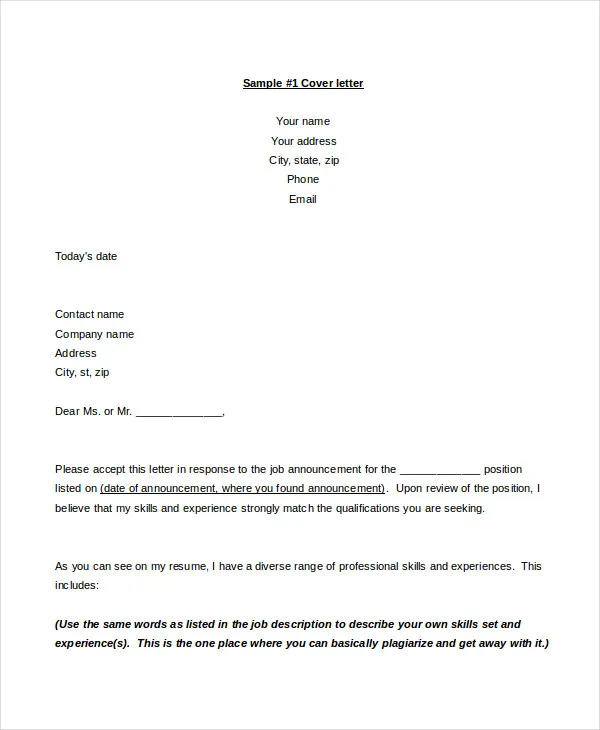What is a Cover Letter
A cover letter is a crucial document that accompanies your resume when applying for a job. It serves as a personalized introduction, allowing you to elaborate on your qualifications, skills, and experiences while expressing your interest in the specific position and the company. Unlike a resume, which provides a concise overview of your professional history, a cover letter gives you the opportunity to showcase your personality, writing abilities, and your understanding of the role and the organization. It’s your chance to make a strong first impression and persuade the hiring manager to consider your application further. The cover letter is a pivotal tool in your job-seeking arsenal and should be crafted carefully.
Why are Cover Letters Important
Cover letters are important because they provide context to your resume. They help the hiring manager understand why you are the right fit for the job. They also allow you to highlight specific skills and experiences that are relevant to the position. Moreover, a well-written cover letter demonstrates your communication skills, your attention to detail, and your genuine interest in the role and the company. It is an opportunity to differentiate yourself from other applicants. In a competitive job market, a cover letter can make or break your chances of getting an interview. Employers often use cover letters to assess your writing skills, your ability to articulate your thoughts, and your understanding of the job requirements.
Cover Letter Secrets: 5 Keys to Success
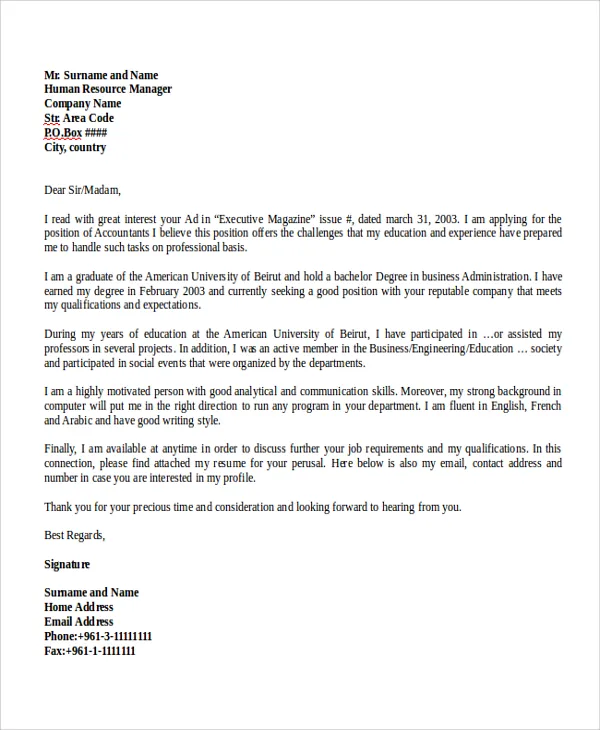
Crafting a winning cover letter involves several key secrets that can significantly increase your chances of landing an interview. Firstly, personalize your cover letter. Tailor each letter to the specific job and company. Secondly, highlight your accomplishments. Instead of merely listing your responsibilities, showcase your achievements with quantifiable results whenever possible. Thirdly, demonstrate your understanding of the company. Research the company’s mission, values, and recent projects, and show how your skills align with their goals. Fourthly, use a professional and engaging tone. Avoid generic phrases and clichés. Fifthly, proofread meticulously. Errors can undermine your credibility; always check grammar and spelling.
Highlighting Your Skills and Experience
When highlighting your skills and experience, focus on the keywords and requirements mentioned in the job description. Use action verbs to describe your accomplishments. Instead of saying you ‘managed projects,’ say you ‘successfully managed cross-functional projects, delivering them on time and under budget.’ Quantify your achievements whenever possible. For example, ‘Increased sales by 15% in one quarter.’ Providing specific examples of how you have used your skills in the past is very important. This allows the employer to see how your skills relate to the requirements of the role. Showing, not just telling, makes your cover letter more compelling and demonstrates your value.
Customizing Your Cover Letter to the Job
Customizing your cover letter to the specific job is crucial for grabbing the hiring manager’s attention. Start by carefully reading the job description and identifying the key requirements and keywords. Then, tailor your cover letter to reflect those requirements. This is more than just changing the company name. It means adjusting your language, highlighting the most relevant skills and experiences, and showcasing how you meet the specific needs of the role. Research the company’s values and culture, and reflect them in your tone and approach. This level of personalization shows you have taken the time to understand the opportunity and are genuinely interested in the role and the organization. Always remember, a generic cover letter is unlikely to impress.
Proofreading and Polishing Your Cover Letter
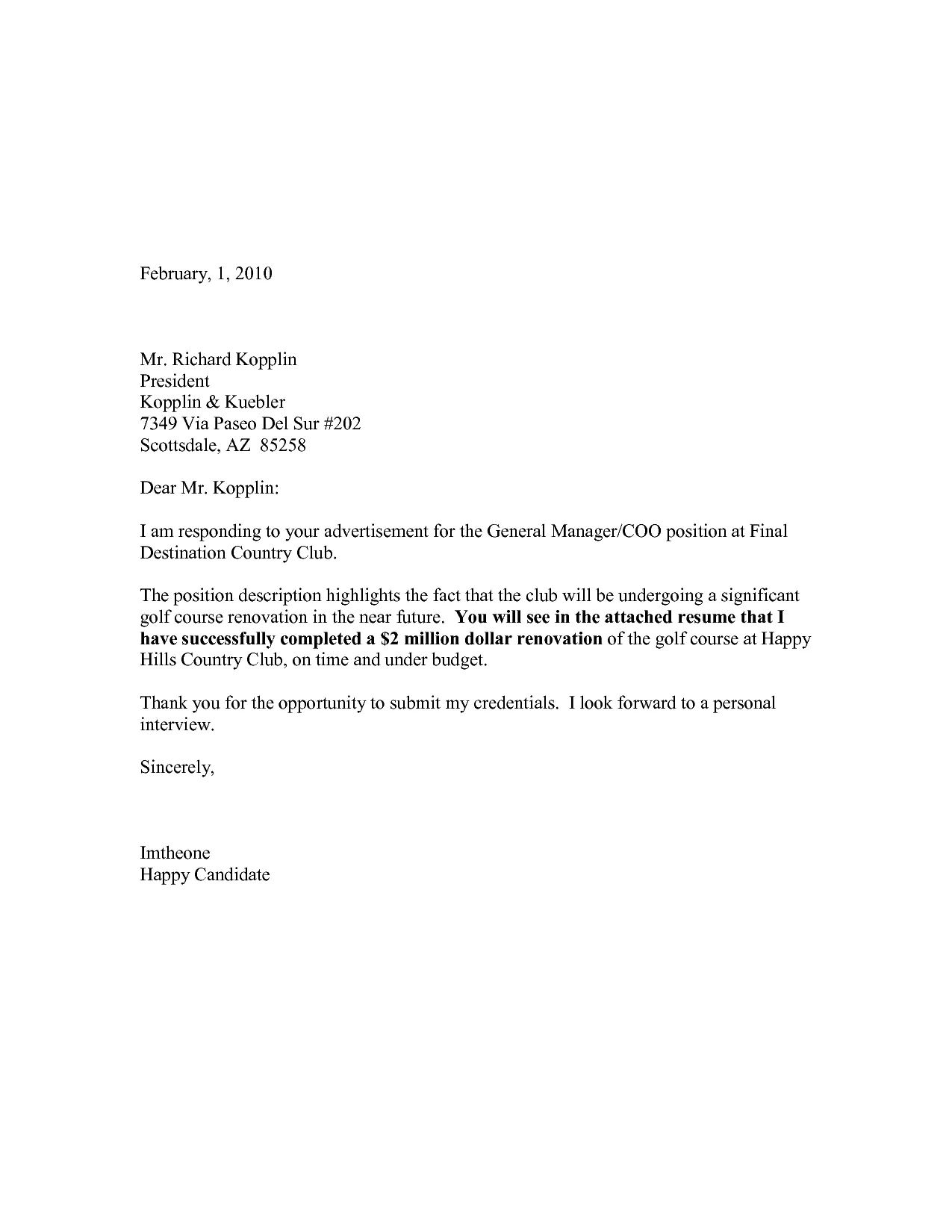
Proofreading and polishing your cover letter is the final step and is an absolute necessity. Typos, grammatical errors, and formatting issues can undermine your professionalism and credibility. Always proofread your cover letter carefully before submitting it. Read it aloud to catch awkward phrasing or errors. Ask a friend or colleague to review it. Use grammar and spell-check tools, but don’t rely on them completely. Make sure your cover letter is well-formatted, with clear paragraphs, proper spacing, and a professional font. A polished cover letter demonstrates your attention to detail and commitment to presenting yourself in the best possible light. Double-check all the details, including the hiring manager’s name and company address.
Cover Letter Examples: What to Include and How to Write
Contact Information and Addressing the Hiring Manager
Your cover letter should begin with your contact information, including your name, phone number, email address, and LinkedIn profile link. Always address the hiring manager by name. If you cannot find the hiring manager’s name, you can use a general greeting such as ‘Dear Hiring Manager.’ Addressing the letter to a specific person shows you have put in the extra effort. It makes your cover letter more personal and increases the chances of being read carefully. Place your contact information at the top of the page, and ensure the formatting is clean and easy to read. Always double-check the spelling of the name and title.
Opening Paragraph: Capturing Attention
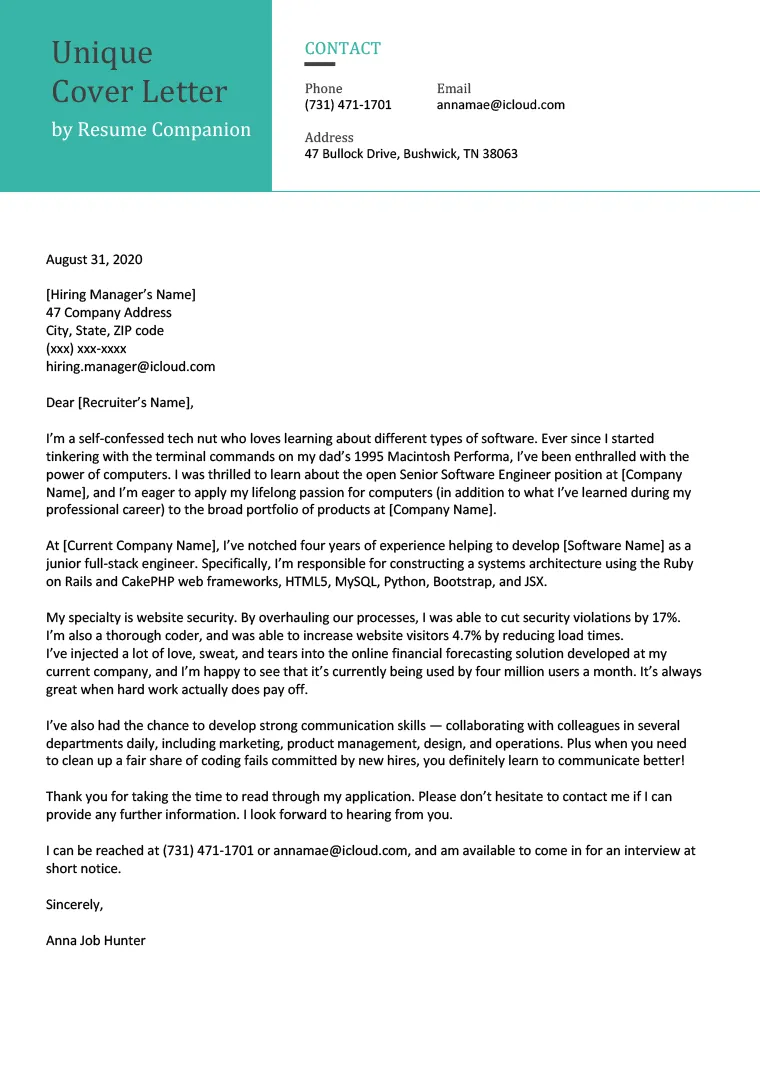
The opening paragraph is your opportunity to make a strong first impression. Start with a compelling statement that immediately captures the hiring manager’s attention. State the position you are applying for and where you found it. Briefly mention why you are interested in the role and the company. Highlight your most relevant skills or experiences to show your immediate value. Avoid generic openings such as ‘I am writing to express my interest…’ Instead, be direct, enthusiastic, and showcase your personality. A well-crafted opening paragraph sets the tone for the rest of your cover letter. It’s also an opportunity to set yourself apart from other candidates.
Body Paragraphs Highlighting Achievements
The body paragraphs should provide specific examples of your skills and accomplishments. Use the STAR method (Situation, Task, Action, Result) to structure your responses and demonstrate your value. Describe the situation you were in, the task you needed to complete, the actions you took, and the results you achieved. Quantify your achievements whenever possible. Use action verbs to showcase your abilities. For example, instead of writing ‘Responsible for managing projects,’ write ‘Managed and delivered 10+ projects, resulting in a 20% increase in efficiency.’ Relate your experiences and achievements directly to the job requirements. Be concise, and focus on the most relevant information.
Closing Paragraph and Call to Action
The closing paragraph should summarize your interest in the role and reiterate your value to the company. Thank the hiring manager for their time and consideration. Express your enthusiasm for the opportunity to discuss your qualifications further. Include a clear call to action, such as ‘I look forward to hearing from you soon’ or ‘I am eager to discuss how my skills can benefit your team.’ Reiterate your contact information. Make it easy for the hiring manager to reach you. Proofread your closing paragraph carefully to ensure it is professional and error-free. The closing paragraph should leave a positive lasting impression.
Cover Letter Examples: Different Formats
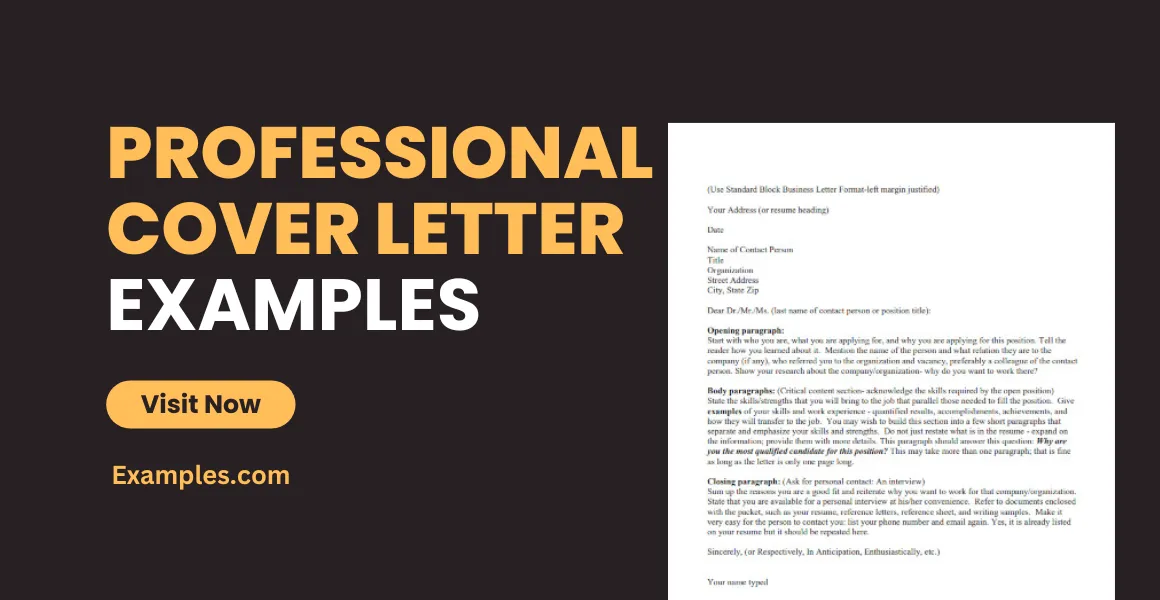
The Traditional Cover Letter
The traditional cover letter is the most common format. It typically includes a formal tone, a clear structure, and a focus on your skills and experiences. It should follow a standard business letter format, including your contact information, the hiring manager’s information, a formal salutation (Dear Mr./Ms. Last Name), a structured body, and a professional closing (Sincerely, Regards). This format is ideal for most industries and job types, and it is generally the default choice unless otherwise specified. It’s a safe and reliable way to introduce yourself. The traditional cover letter is structured, professional, and focuses on the relevant skills and achievements.
The Modern Cover Letter
A modern cover letter incorporates design elements and a more creative tone. It often uses a more visually appealing layout, with the option of a header, bullet points, and a less formal approach. This format can be effective in creative industries or for roles where a strong personality and design sense are an advantage. Use bold fonts and different headings, but ensure the cover letter remains professional. The modern format allows you to showcase your personality and writing style more than the traditional option. If you choose this format, make sure it suits the company culture. Avoid being overly informal. Balance style with professionalism to leave a positive impact.
The Skills-Based Cover Letter
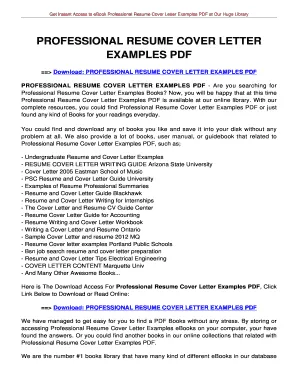
A skills-based cover letter emphasizes your skills and qualifications, which are organized into the same categories mentioned in the job description. This format is helpful if you lack direct experience in the job you are applying for, but have transferable skills from other positions. At the beginning of the cover letter, state the skills that make you a good fit for the job. Use bullet points to highlight each skill. This format is great for career changes, or if you have gaps in your employment history. It allows you to directly address the requirements of the job description. This format puts your skills at the front and center.
Cover Letter Examples: Industry Specific
Different industries often have unique expectations. Tailoring your cover letter is very important. Research the industry’s norms, and adjust your approach accordingly. For example, in creative fields, a more visually appealing and creative cover letter might be appropriate. In more formal industries, such as finance or law, a traditional format is often preferred. You can search for cover letter templates specific to your industry. Ensure you adjust your language, tone, and focus to match the expectations of the industry. The aim is to show you understand and fit into the culture.
Cover Letter Examples for Marketing Professionals
Marketing professionals should showcase their creativity, communication skills, and data-driven results. Focus on your marketing campaigns, and quantify your achievements. Use action verbs. Highlight successful strategies and how they have helped the company. Be creative with your formatting to show you have a good design sense. You want to demonstrate that you have what it takes to create and implement strategies. Show your knowledge of industry trends. Mention metrics and tools. Marketing cover letters are a chance to demonstrate that you understand the company’s branding and message.
Cover Letter Examples for Engineering Jobs
Engineering cover letters should focus on technical skills, problem-solving abilities, and project accomplishments. Use a formal tone. Highlight your ability to work on a team, and list the technologies, tools, and software you have experience with. Emphasize your attention to detail, and highlight your practical experiences. Provide specific examples of projects you have completed, and state any results you achieved. Use technical terms. Proofread for accuracy. Demonstrate your understanding of the industry. An engineering cover letter must showcase your abilities to design, build, and test products.
Cover Letter Examples for Entry-Level Positions
Entry-level cover letters should focus on your transferable skills, academic achievements, and enthusiasm for the role. Highlight any relevant internships, volunteer experiences, or extracurricular activities. If you do not have much experience, discuss your eagerness to learn, your strong work ethic, and your ability to adapt. Customize your cover letter to the specific job and company. Show you have done your research. Demonstrate your willingness to develop your skills. An entry-level cover letter offers the chance to make a strong impression, regardless of your experience level.
Common Mistakes in Cover Letters
Avoiding common mistakes is key to writing a great cover letter. The most common mistakes can damage your chances of getting an interview. Always check your spelling and grammar. Using a generic template or not tailoring the letter to the specific job is very common. Not highlighting your achievements and using too much vague language can make the cover letter ineffective. Not following the instructions in the job posting is another major mistake. A well-written cover letter should avoid these common pitfalls.
Spelling and Grammar Errors
Spelling and grammar errors can severely damage your credibility. They demonstrate a lack of attention to detail and professionalism. Proofread your cover letter carefully, and use spell-check and grammar-check tools. Consider having a friend or colleague review your cover letter. Mistakes can undermine your qualifications, so always make sure your cover letter is free of errors. Never submit a cover letter with spelling or grammar mistakes.
Generic and Uninspired Language
Generic and uninspired language can fail to capture the hiring manager’s attention. Use action verbs, and describe your accomplishments in detail. Show, don’t tell. Use the STAR method to structure your responses and highlight your achievements. Avoid clichés. Instead, demonstrate your personality and enthusiasm for the role. Using a unique and tailored approach is critical to standing out. Generic language is very ineffective; make sure to write a cover letter that is engaging.
